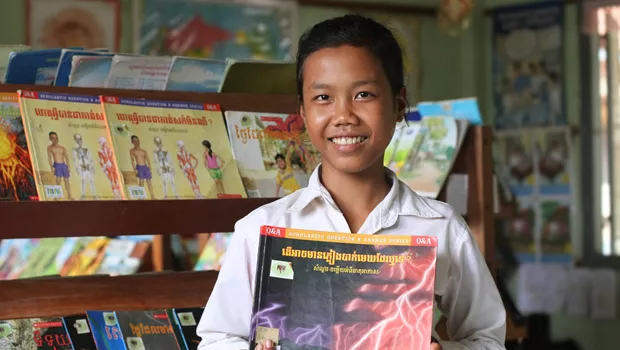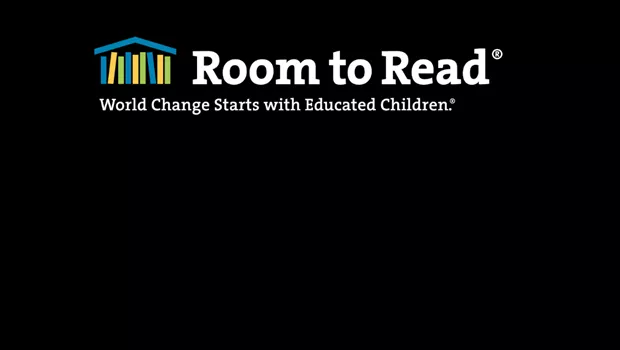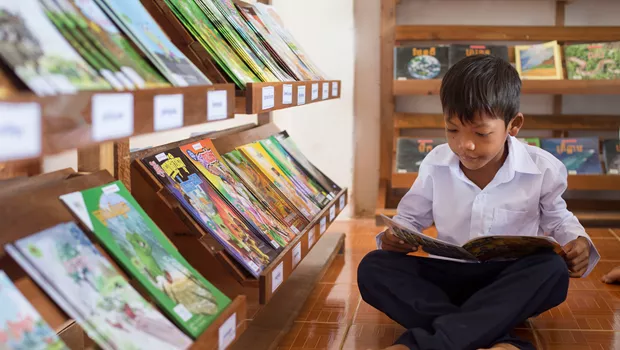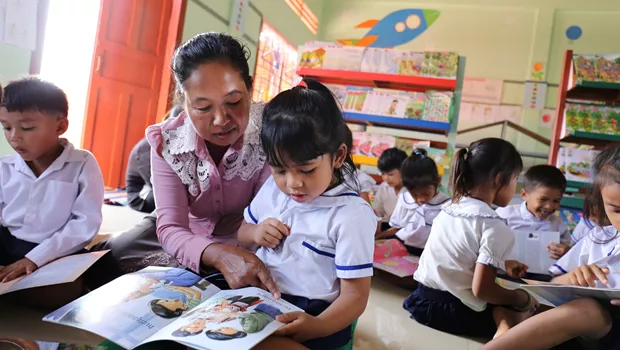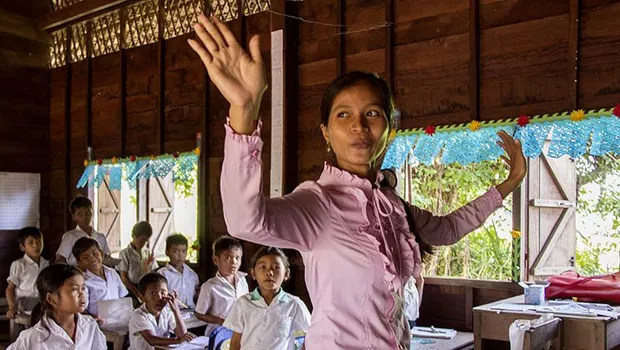“Sam Sat on a Mat” and Other Books That Boost Literacy and Help Children Jump-Start a Habit of Reading
December 19, 2015
Sreynead, a first grader at Svay Antor Primary School in Cambodia’s Prey Veng Province, jostles the boys and girls in her class to get a copy of the final book in the series she’s been reading from the little rattan shelf at the front of the room. One of her class’s top readers, she can already read books 1 through 11 — and as a result, her literacy skills have gone way up.
The simple, cost-effective books in the series aren’t like ordinary children’s books. Known as decodable stories they are an important part of Room to Read’s phonics-based instruction program.
Sreynead smiles as she sits down with book 12. Even though she is seeing some of the words in the new story for the first time, the lessons she’s had over the past few weeks have been systematically building her reading skills in a way that allows her “decode” new words phonetically. Each new book in the series also gives her a chance to review and consolidate what she’s learned while building her confidence in her ability to read independently.
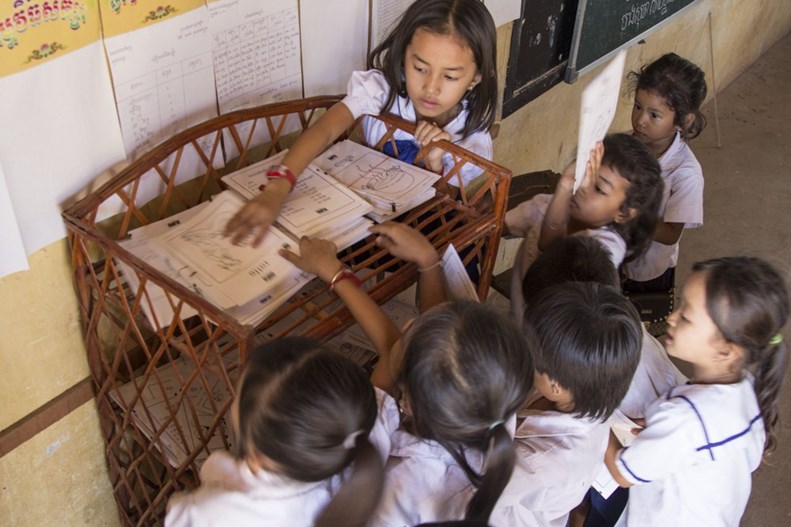 Boys and girls in Cambodia’s Svay Antor Primary School reach for the next decodable story to increase their literacy skills
Boys and girls in Cambodia’s Svay Antor Primary School reach for the next decodable story to increase their literacy skills
What’s in a decodable book?
Learning to read can be an enormous challenge for children who have had little to no exposure to printed words before starting school, which is often the case in low-income countries. Beginning readers like Sreynead benefit from phonics-based literacy instruction that uses decodable stories designed for their level of reading, allowing them to read words on their own.
“We’ve seen a number of studies that found decodable stories to be a crucial part of learning for early grades,” said Alisha Berger, associate director for Room to Read’s Literacy Program.
Phonics-based literacy instruction starts with teaching children phonological awareness, meaning the ability to hear the sounds that make up a word. Students next learn the letter that goes with a particular sound and how to read it when combined with other letters to create words. Once they’re confident reading single words they start reading and comprehending sentences, then stories.
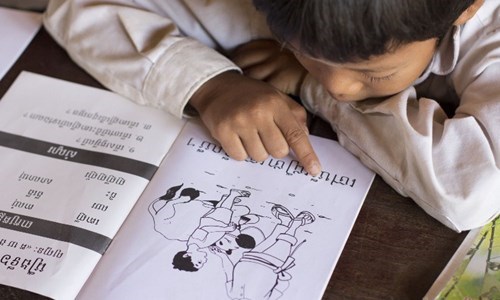
Room to Read’s Literacy Program uses decodable books designed to help children become independent readers
The lesson plans and matching decodable stories in Room to Read’s literacy instruction program take children through this process. For instance, a story that teaches the letter ‘s’ pairs the text “Sam sat on a mat. Sim sat on a mat. Sam and Sim sit.” with an illustration of two boys sitting on a mat. “The story doesn’t have to use the same kind of structure as a regular book,” Alisha noted. “At first students just need a lot of practice using the letters they’ve just been taught.”
Bridging the literacy gap
When a child reads a decodable book made up of words they’ve recently learned in a lesson, they’re actually reading the story on their own — an achievement that can build confidence and an interest in reading early on. This makes decodable books an important bridge between teaching kids how to sound out words in the classroom and reading a typical storybook on their own — a leap that can be challenging.
As Room to Read’s Literacy Program Director Claire Wyatt explained during a meeting with officials from the Cambodian Ministry of Education Youth and Sport, “Early readers often feel a great sense of accomplishment when they can read an entire story on their own. Simple decodable stories provide a great opportunity for this and are much more motivating than just reading individual words.”
What’s more, the decodable stories in a series become more complex as a child’s literacy skills increase, allowing beginning readers to build on their vocabulary and comprehension skills. They can later apply this same approach to reading leveled books, which are children’s books categorized by level of difficulty based on criteria like length of sentences, number of pages and word choice.
 Sreynead, one of her class’s best readers, studies the last decodable story in the series to build her literacy skills
Sreynead, one of her class’s best readers, studies the last decodable story in the series to build her literacy skills
Creating stories from letters
Room to Read began developing decodable stories in 2012 through its Writers’ and Illustrators’ Workshops in Bangladesh, Cambodia and Nepal. What’s challenging about writing a decodable book is creating a story from a very short list of letters and words that aligns with a lesson plan. “It’s like playing Lego where you have certain type of pieces that can fit together and you try to build something,” said Alisha. Since each successive lesson is more advance than the previous one, the authors are allowed a few more words to choose from each time as they build out a series of stories.
Illustrations are also treated differently than they are in ordinary children’s books. To avoid students reading the pictures instead of the text, they must either have multiple meanings or a different meaning from the text. “For instance if the text says ‘The cow walks. The cow hurts it neck’ the illustration for it might be a cow walking with a sad face so we don’t know that it hurts it neck or why it is sad,” Alisha explained.
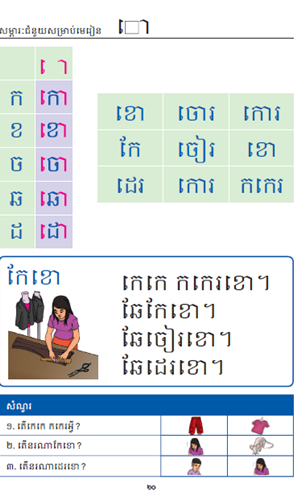
A page from a decodable story in Room to Read Cambodia’s first grade textbook
Room to Read initially piloted 25 decodable stories for first grade and 15 for second grade in Cambodia. The decodable stories have been so successful Room to Read is now integrating them into its new first grade student reading books. “Eventually, every country where we offer literacy instruction will have between 90 and 150 decodable stories in its student books, all of which are being created through Room to Read support,” said Alisha.
The Room to Read Literacy team in Cambodia just delivered its new first grade student books containing 100 new decodable stories to schools this year.
Exploring books in the library
Having reviewed all the words in the lesson for decodable book 12, Sreynead’s teacher Ms. Nhuk instructs her students to try to read the book by themselves. “They’re always excited to read a new book after a lesson,” said Ms. Nhuk. “This is a very good method for teaching literacy.
“Before when they read books in the library they could only read some parts because they hadn’t learned all the letters yet,” she explained, adding that they could get discouraged. Now thanks to the increased confidence her students have developed by reading decodable books, they’re much keener to explore the books in the library.
As for Sreynead, she’s already eager to move on to the next series of decodable books.
Find out more about our Literacy Program.
Learn more about Room to Read and get involved.

